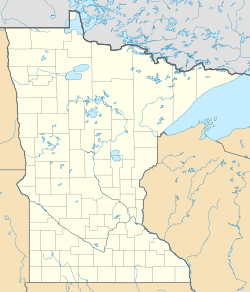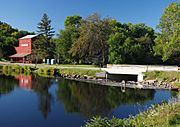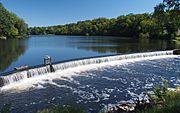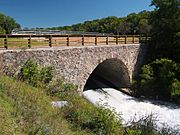Terrace Mill facts for kids
Quick facts for kids |
|
|
Terrace Mill Historic District
|
|
|
U.S. Historic district
Contributing property |
|

The Terrace Mill from the east-northeast
|
|
| Location | Off Minnesota Highway 104, Chippewa Falls Township, Minnesota |
|---|---|
| Nearest city | Sedan, Minnesota |
| Area | 3.8 acres (1.5 ha) |
| Built | 1882, 1903, 1915, 1930 |
| Architect | Jonas M. Danelz (mill, bridge), Peter Takken (house) |
| Part of | Terrace Historic District (ID82002999) |
| NRHP reference No. | 79001252 |
| Added to NRHP | July 17, 1979 |
The Terrace Mill is a historic watermill located in Terrace, Minnesota, in the United States. Today, it works as a museum. A group called the Terrace Mill Foundation manages the mill. Inside, you can find an art gallery, a small theater, and a gift shop. The outdoor areas are used for different events.
The mill and four other buildings nearby are very important. They are listed on the National Register of Historic Places as the Terrace Mill Historic District. This means they are special because they show how people used to do business, build things, and travel in the area.
Contents
The Mill's Journey Through Time
How the Mill Started
The very first flour mill on this spot was built in 1870. It helped grind grain into flour for many years. In the mid-1890s, this first mill was moved to Brooten, Minnesota. This was done so it could be closer to a new train line.
Building the Current Mill
In 1901, a man named Jonas M. Danelz bought the land. Two years later, in 1903, he built the mill you see today. Later, in 1920, Peter Takken bought the mill. He added a diesel engine to make it run better. Peter Takken also built a house for himself in 1930.
Changes Over the Years
Peter Takken stopped grinding grain in 1949. A new owner then turned the mill into a woodworking shop. This shop made special furniture for churches. It operated until 1967. After that, the Terrace Mill was empty for several years.
Saving the Mill
In the mid-1970s, people started working to save the mill. The Terrace Mill Foundation was created in 1979. This group helps to preserve the mill and share its history.
What is the Terrace Mill Historic District?
The Terrace Mill Historic District includes five important parts. These are the mill itself, built in 1903, and four other structures. They are the Stone Arch Bridge from 1903, the Steel Beam Highway Bridge from 1915, the Mill Dam (which might be from 1882), and the Miller's House from 1930.
Why This District is Important
This historic district is special because it shows what small, country mills in Minnesota were like. It still has all the parts needed for a mill powered by water. It's also important because it's where Pope County's first flour mill stood in 1870. The current mill was a big part of the local economy until the 1960s.
The mill building itself is also significant. Its design and the way its water turbine works show how small watermills were built back then. It is one of only about 24 such mills still standing in Minnesota, outside of the big cities of Minneapolis–Saint Paul.
Other Buildings at the Mill
The Terrace Mill Foundation has also moved other old buildings to the mill grounds. These buildings are not part of the official National Register district. One is a log cabin, which was one of the first houses in Terrace. It was rebuilt in the early 1980s. There is also a "heritage cottage" from the 1950s. It shows Scandinavian building styles and furniture.
Pictures of the Mill
Learn More







